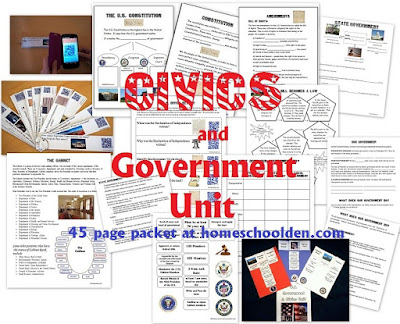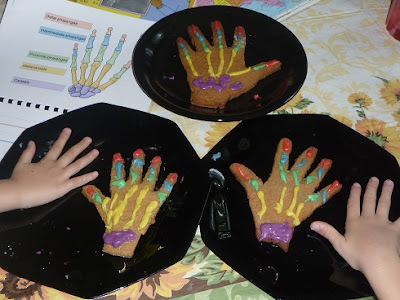Our study of the heart and circulatory system started with a listen to our own heartbeats. We measured our heart rates when resting and after walking, running and skipping. Then using a graph put out by
Texas heart institute (4th grade curriculum, p. 25), we graphed our results.
Heart as a Pump:
 |
| We did this experiment: When your heart beats it acts like a tennis ball filled with water. The heart muscle squeezes blood out of its way. Between beats it goes back to its original shape. The human heart creates enough pressure to squirt blood 30 feet. The kids had a tough time actually squeezing the tennis ball, but they got the idea. |
Our bodies have 5.6 liters of blood. We measured that out in a big pot:
Circulatory System Activity:
This is how Harold looked before we started. I named him to pique the kids' interest!
We sat down together and I explained how blood that has no oxygen heads to the heart and into the lungs. There is picks up oxygen (I said it more along the lines of "OH MY GET ME SOME OXYGEN QUIIIiiiiiCK!"). Then I drew the lines in red showing how the oxygenated blood heads back to the heart and then gets squeezed out to the body. I showed how some blood travels to the brain, some to the arms, fingers, legs, toes, etc. etc.) The blood drops off oxygen and then returns in veins (blue lines) back to the heart where it is sent off to the lungs to pick up more oxygen.

After we drew the lines -- arteries and veins -- together, I got two tiles. I put the blue tile on top and the red tile on the bottom. I traveled from the heart as a blue tile (with red underneath) to the lungs where I flipped over and became the red sided tile. Then I 'drove' my red tile back through the heart and out into the body. I decided to go to the brain to drop of oxygen where I flipped my red tile back to blue. The blue tile traveled along the blue veins back to the heart and then to the lungs.
After we all took a number of turns doing that, we piled blue/red or red/blue tiles all over Harold's body to show the path of blood.
I searched everywhere for a heart-circulatory activity and never found one... but this activity that somehow jumped into my head turned out to be a HUGE hit in our house!! The kids even spent a long time "teaching" Dad what they had learned!
One last picture of this activity:
 |
| Heart and Circulatory Activity |
Blood Activity:
Another day we learned a bit more about blood. We cut open a chicken leg bone (before baking it for lunch) and examined the bone marrow. We had read in one of our books that bone marrow is where blood cells are formed. We took a close look at the bone marrow, poked and prodded.
Then we "made" our own blood. The types of cells made in bone marrow include red cells, white cells and platelets. We talked again about the basic function of these cells.
- the fluid is called plasma (corn syrup)
- red cells carry the oxygen (red jelly beans)
- white cells fight infection (white jelly beans)
- platelets help to clot and form scabs (rice)
Circulatory System Packet
We have just finished studying the Circulatory System again. This time we covered the circulatory system in much more depth. We talked about the heart, pulse, blood vessels, blood flow, blood and the components of blood (red and white blood cells, platelets), blood types, cholesterol, and diseases of the circulatory system. (The kids are currently in grade 3, 6, and 8) It is 40+ pages (plus another 10 pages of lapbook/interactive notebook pages). We did a number of hands-on activities and the instructions (with photos) are included in this packet.
You can find out much more about our packet here at this post:
Circulatory System Packet: Worksheets and Activities or can purchase if through PayPal with the link below.
Today and tomorrow only, it is $3.00! ♥ Happy Valentine's Day! ♥
Once you pay for this packet, you will immediately receive a link to download this file (which will open in a browser window).
You will also receive an email from Sendowl (the service I use) to your PayPal email address, which will have a link you can click on to download the
Circulatory System Packet. (It will say, “You can download your digital products…” with a clickable link.)
Of course, if you have any issues just
email me at — liesl at homeschoolden dot com or reply to the SendOwl email that is sent to you. You can also reach me by using the
contact form on the blog at our new location, homeschoolden.com. ~Liesl
$4.75 $3.00
(today and tomorrow only, until 9am EST Wed. Feb. 15)
Don't forget to check your PayPal email address for the download link.
Here are a couple other screen shots of our packet:
-----------------------------------------------------------
The Wrinkled Heart Activity:
And now on a related, but different note... today I decided to address
the heart in the emotional sense too. I found this wonderful idea at
ProTeacher. It is an activity about the things people say that can be hurtful and the things people say that can be kind. Before I read
Chrysanthemum to
the kids (since that's the book I had on hand), I cut out a heart.
Then after we read the book we talked about the things the mice said
that were hurtful (and I made folds in the heart) and things we've said
to each other that have been hurtful (more folds) and things that
they've heard others say that might be hurtful (more folds). Then we
talked about things we say that are kind (unfold). We said as many kind
things as we could until the heart was unfolded. Then we talked about
how the heart was still wrinkled and how the hurtful things we hear can
linger for a while in our heart. We hung our wrinkled heart in the
homeschool room as a reminder to be kind to one another. What a lovely
idea, don't you think?
--------------------------------------------------------
We have moved to homeschoolden.com. In the years since we moved from this location, we've started creating lots of packets and worksheets. We have a number of science packets.... and our science packets are especially popular. We continue to do a lot of hands-on science [and history], which I think is why the kids love science and history SO much!
Just as an example, this is our
Digestive System Packet which includes lapbook pages, worksheets, plus our hands-on activity ideas.
We have a packet on the
Skeletal System Packet which includes a half-dozen hands on activities.
We also have a packets on
Earth Science,
Cells, and more!
See you soon over at our new location: homeschoolden.com or over at our Homeschool Den Facebook Page. ~Liesl
 We don't have a Magic School Bus, but we did make a pretty wonderful field trip this past (extended) weekend. One of our first stops was the Franklin Institute in Philadelphia. Part of the reason we studied the heart/circulatory system last week instead of going on to muscles and joints was to take advantage of the spectacular interactive science display at the Franklin Institute.
We don't have a Magic School Bus, but we did make a pretty wonderful field trip this past (extended) weekend. One of our first stops was the Franklin Institute in Philadelphia. Part of the reason we studied the heart/circulatory system last week instead of going on to muscles and joints was to take advantage of the spectacular interactive science display at the Franklin Institute.






















































